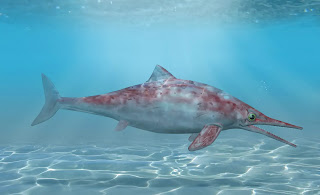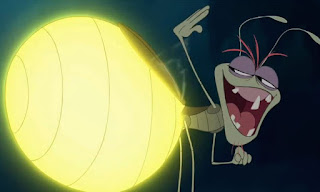Ancient Seas #7
Ancient Seas
Ichthyosaurus
 |
| Photo from DK Find Out! |
Kingdom: Animalia
Class: Reptilia
Conservation Status: Extinct (EX)
Era: Late Triassic - Early Jurassic
WHAT WAS IT?
Discovered in the early 19th century, Ichthyosaurus was a large marine reptile which belongs to the order of Ichythosaurs. From the early Triassic to late Cretaceous eras, there were at least fifty species of Ichythosaur roaming the ancient seas. It is believed they evolved from a land reptile which returned to the sea - much like with whales and dolphins - and came to look similar over the years through convergent evolution. The Ichthyosaurus is the type genus of the spieces.
WHAT DID IT LOOK LIKE?
This marine reptile looked rather similar to dolphins, it is believed. They had dorsal fins, flippers, and a large caudal fin. In comparison to the others of the species, Ichthyosaurus was around the average size for the genus - measuring at around 3.3m (10.8ft) - whereas other species found could grow up to 21m (66ft)! One distinct feature of the Ichthyosaurus is their long snout, filled with small teeth.
Their body evolved to make the adept swimmers. Despite evolving from a species which did not have any lumps on their back, Ichthyosaurs developed dorsal fins and fully formed flippers to help them move through the water. They very much looked like fish, even though they were reptiles. Unlike fish, however, their skin was smooth and elastic-y rather than scaled.
 |
| Photo from Wikipedia |
HOW DID THEY LIVE?
Being reptilian, despite their fish-like appearance, warm-blooded Ichthyosaurus breathed air. They carried a lot of blubber on their bodies to keep them warm, especially as they were known to dive to great depths. It was postulated that these creatures would have spent some time in the sea and some on land, but further discoveries proved that they spent their entire lives in the water. While a lot of marine reptiles comes to land to lay their eggs, Ichythosaurus gave birth to live young under the sea, making them vivaparous. They birthed their young tail first so that they did not drown.
These ancient creatures were predators. Their longevity and variety suggests that they had a wide range of prey and were successful hunters. They had large, sensitive eyes which were protected by a bony shield. This indicates that they hunted at night or at great depth. It is believed that sight was the main sensory tool used when hunting as their hearing is considered to be poor.
WHAT DID THEY EAT?
The Ichthyosaurus, being a more averaged size of the genus, probably ate cephalopods and fish. Their snout was filled with conical teeth designed for slashing at their prey - much like how swordfish hunt. But, like most denizens of the sea, they were opportunistic eaters. If something drowned and dead cross their paths, they would eat that too. Larger species of Ichthyosaur had much bigger, more blade-like teeth which they would have used to hunt much bigger prey. Even creatures a similar size to themselves!
 |
| Photo from Phys.org |
FUN FACTS
- Ichthyosaurus means "fish lizard" in Greek.
- The speices as a whole died out for unknown reasons.
- Ichthyosaurus was discovered by Mary Anning, our favourite fossil collecting Victorian!
- Joseph Victor Von Scheffels penned a poem about Ichthyosaurus.
Listening to: Alone Again



Comments
Post a Comment